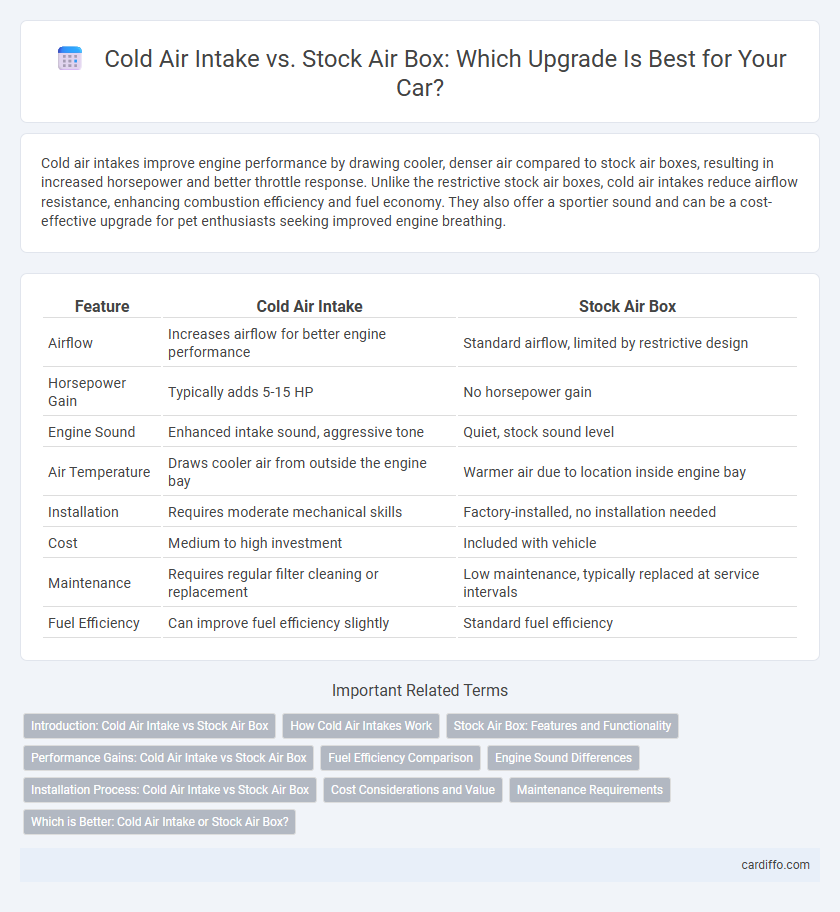Cold air intakes improve engine performance by drawing cooler, denser air compared to stock air boxes, resulting in increased horsepower and better throttle response. Unlike the restrictive stock air boxes, cold air intakes reduce airflow resistance, enhancing combustion efficiency and fuel economy. They also offer a sportier sound and can be a cost-effective upgrade for pet enthusiasts seeking improved engine breathing.
Table of Comparison
| Feature | Cold Air Intake | Stock Air Box |
|---|---|---|
| Airflow | Increases airflow for better engine performance | Standard airflow, limited by restrictive design |
| Horsepower Gain | Typically adds 5-15 HP | No horsepower gain |
| Engine Sound | Enhanced intake sound, aggressive tone | Quiet, stock sound level |
| Air Temperature | Draws cooler air from outside the engine bay | Warmer air due to location inside engine bay |
| Installation | Requires moderate mechanical skills | Factory-installed, no installation needed |
| Cost | Medium to high investment | Included with vehicle |
| Maintenance | Requires regular filter cleaning or replacement | Low maintenance, typically replaced at service intervals |
| Fuel Efficiency | Can improve fuel efficiency slightly | Standard fuel efficiency |
Introduction: Cold Air Intake vs Stock Air Box
Cold air intake systems improve engine performance by increasing airflow and reducing air temperature compared to stock air boxes. Stock air boxes restrict airflow to prioritize noise reduction and emissions compliance, often limiting engine efficiency. Upgrading to a cold air intake can enhance horsepower, throttle response, and fuel economy by delivering cooler, denser air directly to the engine.
How Cold Air Intakes Work
Cold air intakes enhance engine performance by drawing cooler, denser air from outside the engine bay, which increases oxygen levels for combustion compared to the warmer air inside a stock air box. This denser air improves fuel efficiency and horsepower by optimizing the air-fuel mixture in the combustion chamber. Unlike stock air boxes that restrict airflow, cold air intakes reduce air resistance, allowing the engine to breathe more freely and boost overall performance.
Stock Air Box: Features and Functionality
The stock air box is engineered to provide optimal filtration and noise reduction while maintaining consistent airflow to the engine. It features a sealed design that protects the intake system from dirt and debris, ensuring long-term engine reliability. The air box's carefully calibrated airflow path balances performance with emissions compliance and fuel efficiency.
Performance Gains: Cold Air Intake vs Stock Air Box
Cold air intakes enhance engine performance by increasing airflow and reducing air temperature compared to stock air boxes, resulting in improved horsepower and torque output. Stock air boxes often restrict airflow due to their design constraints and warmer air intake location, limiting engine efficiency. Upgrading to a cold air intake system delivers noticeable acceleration improvements and better throttle response by optimizing air volume and cooling.
Fuel Efficiency Comparison
Cold air intake systems improve fuel efficiency by increasing airflow and delivering cooler, denser air to the engine, which enhances combustion and reduces fuel consumption compared to stock air boxes. Stock air boxes often restrict airflow and heat the intake air, leading to less efficient combustion and higher fuel usage. Upgrading to a cold air intake can result in noticeable gains in miles per gallon (MPG) and overall engine performance.
Engine Sound Differences
Cold air intakes produce a deeper, more aggressive engine sound compared to the stock air box, enhancing the auditory experience during acceleration. The design of cold air intakes allows for increased airflow, which intensifies the engine's intake noise and contributes to a sportier tone. Stock air boxes, designed for noise reduction and filtration, result in a quieter, more subdued engine sound under normal driving conditions.
Installation Process: Cold Air Intake vs Stock Air Box
The installation process of a cold air intake typically involves removing the stock air box, disconnecting sensors, and securing the intake system with provided clamps and mounting hardware, which can take 1 to 2 hours depending on vehicle model and user experience. Stock air boxes are factory-installed and designed for straightforward maintenance access without modifications, making their replacement or reinstallation quicker and simpler. Cold air intake systems often require basic mechanical skills and tools like screwdrivers and wrenches, while stock air boxes usually need minimal tools for filter changes or minor adjustments.
Cost Considerations and Value
Cold air intake systems typically cost between $150 and $400, offering improved airflow and potential horsepower gains, while stock air boxes generally have no extra cost as they come standard on vehicles. Investing in a cold air intake can provide better engine performance and fuel efficiency, but it's crucial to weigh these benefits against the initial purchase and possible installation expenses. The stock air box remains a cost-effective, reliable option with minimal maintenance, making it a suitable choice for budget-conscious drivers prioritizing long-term value.
Maintenance Requirements
Cold air intakes typically require more frequent maintenance, including regular cleaning or replacing of the air filter to prevent dirt buildup and maintain optimal airflow. Stock air boxes are generally designed for long-term durability with sealed filters that need less frequent attention, reducing maintenance time but potentially sacrificing some airflow efficiency. Choosing between the two depends on balancing performance benefits and the willingness to perform more hands-on upkeep.
Which is Better: Cold Air Intake or Stock Air Box?
Cold air intakes improve engine performance by increasing airflow and reducing intake air temperature compared to stock air boxes, which typically restrict airflow due to their enclosed design. While stock air boxes offer better filtration and quieter operation, cold air intakes enhance horsepower and throttle response, making them the preferred choice for performance upgrades. The best option depends on the balance between desired power gains and maintenance preferences.
Cold Air Intake vs Stock Air Box Infographic

 cardiffo.com
cardiffo.com